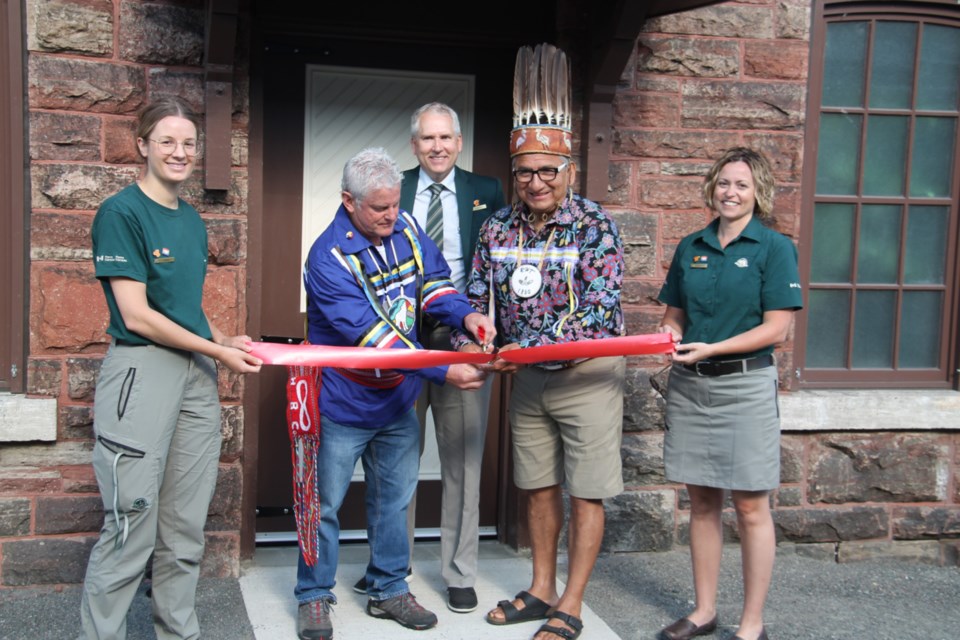After years of painstaking restorative work, the Sault Ste. Marie Canal National Historic Site’s stores building - now known as the Sault Ste. Marie Canal Visitor Centre - was officially opened to visitors Friday.
Parks Canada officials, Indigenous and Metis leaders cut the ribbon and opened the doors after delivering speeches to visitors and Tourism SSM officials.
Batchewana First Nation Chief Dean Sayers, speaking to an audience gathered on a key piece of traditional Indigenous land at the Canal site, told a moving story of how a birch bark canoe, included as one of the Centre's exhibit items, transported the remains of six Batchewana First Nation ancestors to a cemetery at Goulais Mission in 2010.
The remains of the ancestors were removed from Indigenous land by the U.S. military on what is now the Canal site and taken to America a century and a half ago for medical experiments.
The remains were retrieved from the Smithsonian Institute in Washington, D.C. by the Sault Tribe of Chippewa Indians and later delivered to Batchewana First Nation Indigenous leaders on the Canadian side of the border.
The canoe was big enough to carry the human remains in six small coffins along the St. Marys River before being transported north of the Sault.
“The canoe that’s in here, and the stories, are truly the history of Baawaating and Sault Ste. Marie, and truly don’t let us forget the history and how we’re not going to let history repeat itself as we move together more parallel and in alignment with what we originally promised each other, to share,” Sayers told Friday’s audience.
The repatriation of the remains in 2010 was met with crowds of supporters along the way.
“The story of the canoe that’s in here is a beautiful story. Being able to tell stories in places like this is really important to us in addition to the other venues we have to tell the stories like in the schools, colleges, universities and wherever we can. In conjunction with Canada we’ll be able to tell these stories,” Sayers said.
“I truly believe this location is one of the gems of Parks Canada, with so much potential, so much to offer and so much more to come. This is an important day because it marks the end of phase one. I can’t tell you how happy I am about the prospect of the future phases which will eventually include the restoration of the power house, the inclusion of outdoor interpretive elements and the historic welcome gates at the entrance of the site,” said Sharon Hayes, Parks Canada field unit superintendent for northern Ontario.
“This is the first time that we’ve brought Indigenous history to the forefront of the visitor experience at the canal and we’re really proud and excited to have been able to work with the Metis Nation and Batchewana First Nation,” Hayes said, speaking to SooToday.
“We’re very excited. Any time that you have the opportunity to tell the story of Baawaating and the original meeting place to tourists is a great one. The canal’s been a wonderful partner for us over the last several years. We bring several bus tour groups, the cruise ships’ passengers, lots of visitors to the site. We’re really excited there’s an added opportunity for them to be able to come and expand their interpretation and spend some time visiting here and learn the stories of our area,” said Alana Kenopic, City of Sault Ste. Marie manager of tourism and travel.
The cost of restoration and transformation of the former stores building into the Sault Ste. Marie Canal Visitor Centre amounted to approximately $4 million, said Carly Wetzl, Sault Ste. Marie Canal National Historic Site acting site manager.
The centre had a ‘soft’ opening on June 6 before Friday’s official opening, Wetzl said.
“It’s been really busy already. We’ve had lots of tour groups come in, school groups and tourists from across the country and local as well. We’re hoping that this grand opening event helps to inform local tourists, from across Canada and abroad that we’re open and excited to share our new Visitor Centre and exhibit.”
“It’s a multi-phase, multi-year project. It’s ongoing. The next phase that we’re looking at will be the exterior interpretation panels and having a new entryway structure to formally welcome visitors and then the power house restoration project,” said Alisha Rosset, acting visitor experience/product development officer.
The second floor of the Visitor Centre will be eventually opened to visitors and provide a link to upper ground level at the Canal site, where the Locks, Parks Canada office, parkland and the superintendent’s house are located, Rosset said.
Work began on the ambitious stores building project in 2016.
Over the years, the stores building’s foundation shifted and for safety reasons the building was closed in 2010.
Crews carefully removed each individual stone from the south wall’s red sandstone surface, cataloguing and safely storing each one while the building’s foundation was repaired.
Most of the original red sandstones from the south wall were put back in place, while the newer stones are red sandstone replacements.
The stores building/Visitor Centre project stemmed from over $12 million in funding given to the Sault Ste. Marie Canal National Historic Site by the former Conservative government of Stephen Harper in 2015.
That funding included:
- $1.2 million for repairs to the superintendent's residence
- $2.2 million toward the stores building restoration
- $5.9 million for restoration and protection of the site's powerhouse and associated structures
- $3 million for design and repaving of the site's entry road
